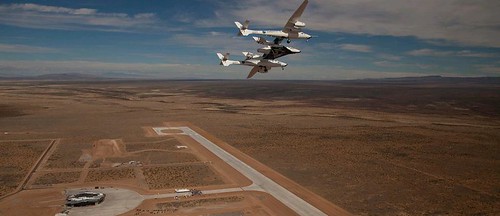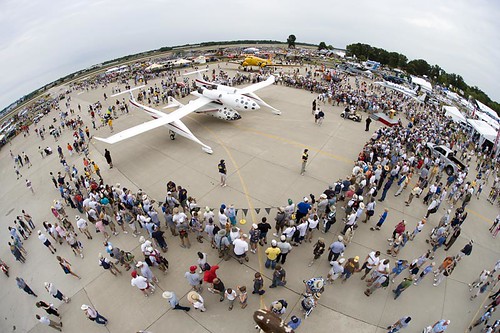Fly The White Knight
Monday, October 25th, 2010

Virgin Galactic’s Spaceport in New Mexico is open and ready to make good on the $50 million in deposits it’s taken in from prospective space tourists after a runway dedication on Friday…
The New Mexico Spaceport Authority (NMSA) today dedicated the nearly two-mile long “Governor Bill RIchardson Spaceway” at Spaceport America, representing significant progress toward launching commercial customers into space from the desert of New Mexico. Governor Bill Richardson, Sir Richard Branson and approximately 30 of more than 380 Virgin Galactic future astronauts attended the event along with guests from around the world and watched a flyover and landing by Virgin Galactic’s WhiteKnightTwo, in a captive carry with SpaceShipTwo.
“We are celebrating the world’s first spaceway at the world’s first purpose-built, commercial spaceport,” said Governor Richardson. “New Mexico is not only helping to launch the commercial spaceflight industry, but we are launching new jobs and opportunities for the people of southern New Mexico. Today marks a significant milestone on our historic and exciting journey.”
The nearly two-mile long runway was officially named the “Governor Bill Richardson Spaceway” at the event, and Governor Richardson joined Sir Richard in placing their handprints in clay as a permanent commemoration of the historic day. NMSA Chairman Ben Woods said the board of the NMSA had met early today to formally and unanimously approve the name of the spaceway.
Sir Richard Branson commented, “It is incredible to be here today with Governor Richardson and be part of the runway dedication at Spaceport America. To see for myself how far the construction has come from when I last visited New Mexico is truly inspiring – I for one can’t wait for the grand opening – today has brought it one step closer to reality for me. The last few weeks have been some of the most exciting in Virgin Galactic’s development. Our spaceship is flying beautifully and will soon be making powered flights, propelled by our new hybrid rocket motor, which is also making excellent progress in its own test program. The investment deal with our new partners Aabar has successfully closed, securing funding for the remainder of the development program and we are seeing unprecedented numbers of people coming forward to secure their own reservations for this incredible experience. To be here in New Mexico to witness this historic moment is the perfect end to a great month.”
They’ve got 380 "future astronauts?" Not too shabby.

Great piece by Diane Alba in the Las Cruces Sun-News…
Going into Friday, an unanswered question lingered in the air at Spaceport America: Would Virgin Galactic’s carrier plane and spaceship actually touch down on their inaugural visit to – dare we say – a "virgin" runway?
Since March, officials had advertised that the vehicles, WhiteKnightTwo and SpaceshipTwo, would participate in a "flyover" at Friday’s runway dedication ceremony.
And sure enough, soon after arriving in spaceport air space, the vehicles were piloted over the runway and nearby 600-person crowd several times.
After catering plenty to the spectators and their cameras, the plane disappeared out of sight, presumably to start the 800-mile trip back to Mojave, Calif., its home base.
Meanwhile, spaceport officials and Virgin Group head Richard Branson continued the event with a press conference. And about 10 minutes into it, Branson interrupted with some unsolicited remarks:
"I rang the pilot of the spaceship and said, ‘Look, we’ve got a runway here. Why are you going back to Mojave? Why can’t you come and sort of show it off?"
Branson then encouraged the audience to put their own "vibes" into the sky, in an attempt to persuade the pilots to turn back and get them to land.
The audience obliged, seemingly eagerly, with cheers and squinching finger motions to send out their "vibes." A few people busted out in a jig.
About 10 minutes later, Branson again told the audience to send out vibes and clap until the aircraft returned. And, after a couple minutes of clapping, the plane and spaceship were back in sight. Not long after, the duo had landed.
A plan was in the works all along for WhiteKnightTwo to touch down on the runway, said an official with Scaled Composites, the company partnering with Virgin Galactic to build the airplane.
WhiteKnightTwo, carrying SpaceshipTwo, wasn’t the first aircraft to land on the new, 10,000-foot runway. Earlier in the day, Branson, New Mexico Gov. Bill Richardson and other dignitaries arrived at the ceremony in Branson’s plane, "Galactic Girl." And a spaceport official said another smaller aircraft has landed previously.
Yeah, there’s video…










